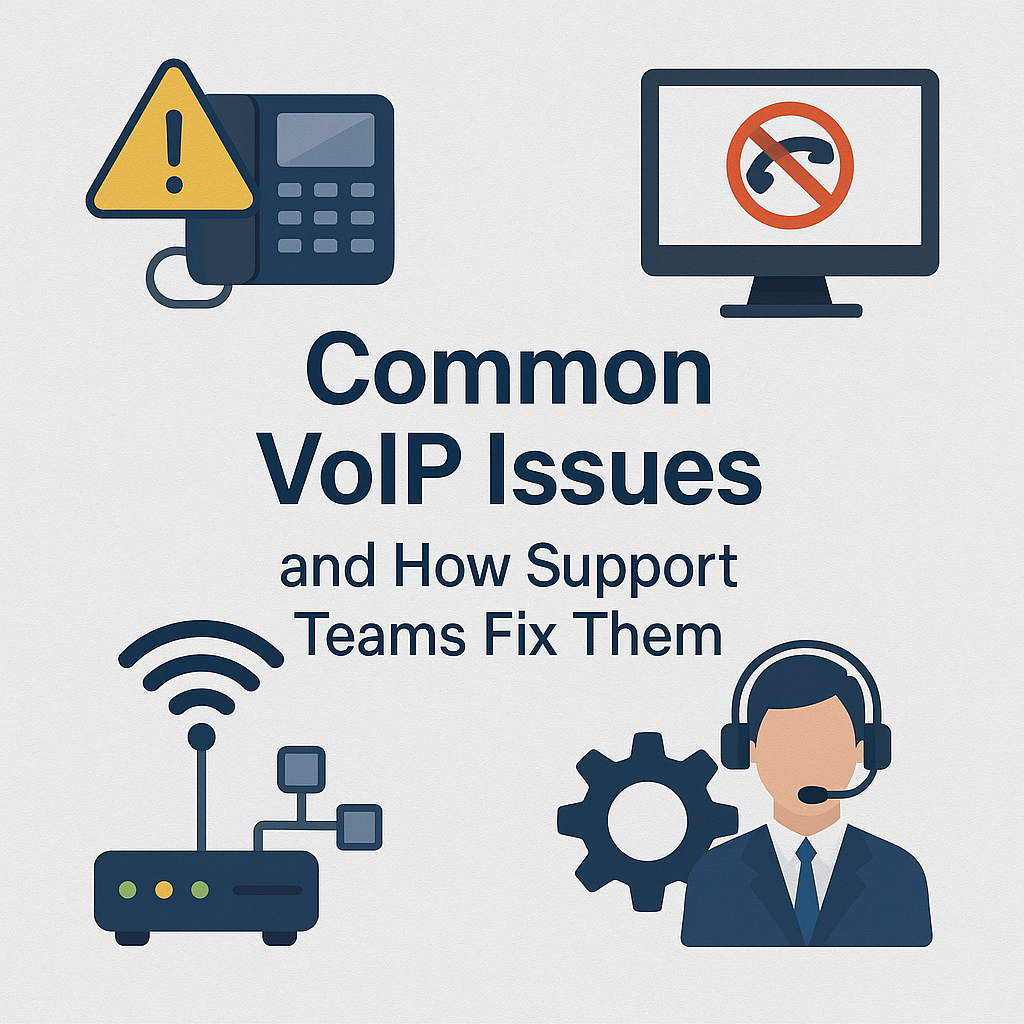How to Scale VoIP Support with a Growing Business

As companies expand, their communication infrastructure must evolve to support increased call volumes, additional team members, and more complex operational requirements. Voice over Internet Protocol (VoIP) technology offers scalable solutions that can grow alongside your business, but implementing these systems effectively requires strategic planning and proper execution.
Understanding VoIP scalability challenges
Growing businesses face unique communication hurdles that traditional phone systems simply cannot address efficiently. When customer inquiries multiply and support teams expand, organizations need flexible solutions that maintain service quality while accommodating increased demand.
The challenge lies not just in handling more calls, but in maintaining consistent service levels, integrating with existing business tools, and ensuring reliable connectivity across multiple locations or remote workers. Many companies discover that their initial VoIP setup, which worked perfectly for a small team, becomes inadequate as operations scale.
Core benefits of scalable VoIP systems
Modern VoIP platforms deliver significant advantages over legacy phone systems, particularly for expanding organizations. These benefits extend far beyond simple cost savings, offering operational improvements that directly impact business growth.
Cost efficiency at scale becomes increasingly apparent as businesses grow. Traditional phone systems require expensive hardware additions for each new line, while VoIP solutions typically offer per-user pricing that decreases as volume increases. This economic model aligns perfectly with business growth patterns, ensuring communication costs remain predictable and manageable.
Flexibility in deployment allows growing companies to add or remove users instantly, support remote workers seamlessly, and adapt to changing business requirements without lengthy installation processes. This agility proves invaluable during rapid expansion phases or seasonal fluctuations in staffing needs.
Advanced feature integration provides growing businesses with sophisticated tools like automated call routing, detailed analytics, CRM integration, and multi-channel communication capabilities. These features, often prohibitively expensive in traditional systems, become standard components of scalable VoIP solutions.
Essential infrastructure requirements
Building a scalable VoIP support system requires careful attention to underlying infrastructure components that will support current needs while accommodating future growth. The foundation you establish today determines how smoothly your system can scale tomorrow.
Network capacity planning
Internet bandwidth forms the backbone of any VoIP implementation. Each concurrent call typically requires 80-100 kbps of bandwidth, but this baseline calculation must account for other network activities, peak usage periods, and quality of service requirements.
Professional networks implement Quality of Service protocols to prioritize voice traffic over less critical data transfers. This prioritization ensures call quality remains consistent even when network utilization increases during busy periods.
Redundancy planning protects against service interruptions that could cripple customer support operations. Multiple internet connections, backup power systems, and failover procedures provide the reliability that growing businesses demand.
Hardware considerations
Server infrastructure must handle increasing call volumes without performance degradation. Cloud-based solutions often provide better scalability than on-premises systems, automatically allocating resources based on demand and eliminating the need for capacity planning guesswork.
Endpoint devices should support advanced VoIP features while remaining cost-effective for large deployments. IP phones with programmable buttons, high-definition audio, and power-over-Ethernet capabilities provide professional functionality without excessive complexity.
Network equipment including switches, routers, and firewalls must support VoIP traffic prioritization and security requirements. Managed switches with VoIP-aware features can significantly improve call quality and simplify troubleshooting.
Choosing the right providers for enterprise scaling
When scaling VoIP support for growing businesses, selecting appropriate providers becomes crucial for long-term success. Enterprise VoIP providers offer specialized solutions designed to handle complex organizational requirements, extensive user bases, and mission-critical communication needs that smaller providers may not adequately support.
Popular VoIP services including Microsoft Teams Phone, Cisco Webex Calling, and RingCentral have established themselves as industry leaders through proven scalability and comprehensive feature sets. These platforms demonstrate consistent performance across thousands of users while maintaining the reliability that growing businesses require.
The landscape of best VoIP suppliers extends beyond household names to include specialized providers like 8×8, Vonage Business, and Dialpad, each offering unique advantages for specific business models. Evaluating these options requires understanding your organization’s specific growth trajectory and operational requirements.
Among the biggest VoIP companies, providers like Zoom, GoTo, and Nextiva have built extensive infrastructure capable of supporting enterprise-scale deployments. These organizations invest heavily in redundancy, security, and feature development that benefits growing businesses seeking reliable communication platforms.
Effective VoIP support from your chosen provider becomes increasingly important as your system scales. Enterprise-grade support includes dedicated account management, priority technical assistance, and proactive system monitoring that prevents issues before they impact your operations.
Strategic implementation approaches
Successfully scaling VoIP support requires methodical planning that addresses both immediate needs and long-term growth objectives. The implementation approach you choose will significantly impact system performance, user adoption, and overall project success.
Phased deployment methodology
Rolling out VoIP systems in phases allows organizations to learn from early deployments while minimizing disruption to ongoing operations. Start with pilot groups who can provide feedback and help identify potential issues before full-scale implementation.
Begin with departments that have predictable calling patterns and technical aptitude. These early adopters can become internal champions who help train other teams and provide valuable insights about user experience improvements.
Gradually expand deployment to more complex departments while continuously monitoring system performance and user satisfaction. This measured approach prevents overwhelming both the technical infrastructure and support resources.
Training and change management
User adoption determines the ultimate success of any VoIP implementation. Comprehensive training programs should cover not just basic calling features, but advanced functionality that can improve productivity and customer service quality.
Create role-specific training materials that focus on features most relevant to different user groups. Customer service representatives need different skills than managers or technical staff, and targeted training improves both efficiency and user satisfaction.
Establish ongoing support processes for users who encounter difficulties or want to learn additional features. This support system becomes even more critical as the organization grows and new employees join the team.
Technology integration strategies
Modern VoIP systems must integrate seamlessly with existing business applications to maximize efficiency and provide comprehensive customer service capabilities. These integrations become increasingly important as businesses scale and require more sophisticated operational coordination.
CRM system connectivity
Customer Relationship Management integration transforms VoIP systems from simple communication tools into comprehensive customer service platforms. When calls automatically display customer information, support representatives can provide personalized service that improves satisfaction and resolution times.
Advanced integrations enable automatic call logging, contact creation, and activity tracking within CRM systems. This automation reduces administrative overhead while ensuring complete customer interaction records for future reference.
Screen pop functionality presents relevant customer information immediately when calls arrive, eliminating the time representatives spend searching for account details. This efficiency gain becomes more valuable as call volumes increase with business growth.
Help desk and ticketing systems
Integration with help desk platforms creates seamless workflows between phone support and ticket management systems. Calls can automatically generate support tickets, ensuring nothing falls through administrative cracks as volume increases.
Advanced integrations enable representatives to access ticket histories during calls, providing context that improves problem resolution efficiency. This capability becomes essential as businesses handle more complex customer issues requiring multiple touchpoints.
Automatic escalation rules based on call duration or customer priority levels ensure appropriate resource allocation without manual intervention. These automated processes maintain service quality standards even during peak demand periods.
Performance monitoring and optimization
Scaling VoIP support successfully requires continuous monitoring of system performance and proactive optimization to maintain service quality as demand increases. Effective monitoring strategies identify potential issues before they impact customer experience.
Key performance indicators
Call quality metrics including Mean Opinion Score, jitter, and packet loss provide quantitative measures of system performance. These technical indicators often predict user experience issues before complaints arise.
Capacity utilization tracking helps identify when system resources approach limits that could affect performance. Proactive capacity management prevents service degradation during peak usage periods.
User satisfaction surveys and feedback collection provide qualitative insights that complement technical metrics. This human perspective often reveals optimization opportunities that technical monitoring might miss.
Proactive maintenance strategies
Regular system updates and patch management prevent security vulnerabilities while ensuring access to latest features and performance improvements. Scheduled maintenance windows minimize disruption to business operations.
Preventive monitoring identifies trends that could indicate developing problems. Addressing these issues before they affect users prevents costly emergency repairs and maintains consistent service quality.
Performance benchmarking against industry standards helps organizations understand whether their VoIP implementation meets professional expectations and identifies areas for improvement.
Security considerations for scaled systems
As VoIP systems grow to support larger organizations, security requirements become more complex and critical. Protecting voice communications and maintaining compliance with industry regulations requires comprehensive security planning.
Network security protocols
Encryption of voice traffic protects sensitive customer conversations from interception. Modern VoIP systems support Transport Layer Security protocols that provide military-grade protection without significantly impacting call quality.
Network segmentation isolates VoIP traffic from other business systems, reducing attack surfaces while improving performance. Virtual LANs dedicated to voice traffic provide both security and quality benefits.
Access control systems prevent unauthorized system access while maintaining usability for legitimate users. Multi-factor authentication and role-based permissions provide security without creating administrative burdens.
Compliance requirements
Industry-specific regulations like HIPAA or PCI-DSS impose additional security requirements on VoIP systems handling sensitive information. Understanding these requirements early in the planning process prevents costly retrofit modifications.
Call recording and retention policies must balance operational needs with privacy requirements and storage costs. Automated policies can manage these requirements consistently across growing organizations.
Audit trail capabilities provide documentation required for compliance reporting while supporting troubleshooting and performance optimization efforts.
Cost management during scaling
Managing VoIP expenses during business growth requires balancing service quality with budget constraints while planning for future expansion. Effective cost management strategies optimize spending without compromising essential functionality.
Licensing and subscription models
Per-user pricing models typically offer better value as organizations scale, but understanding usage patterns helps optimize license allocation. Some users may require advanced features while others need only basic functionality.
Volume discounts often become available at specific user count thresholds. Planning expansion around these breakpoints can provide significant cost savings for growing organizations.
Feature tiering allows organizations to provide appropriate functionality levels to different user groups without paying for unnecessary capabilities across the entire deployment.
Return on investment analysis
Productivity improvements from advanced VoIP features often justify higher per-user costs through reduced call handling times and improved customer satisfaction. Quantifying these benefits helps justify investment decisions.
Reduced infrastructure costs compared to traditional phone systems provide ongoing savings that accumulate as organizations grow. These savings often fund additional features or capacity expansion.
Improved customer service capabilities can directly impact revenue through better customer retention and increased sales conversion rates. Tracking these metrics helps demonstrate VoIP system value.
Future-proofing your VoIP infrastructure
Building VoIP systems that can adapt to future business requirements requires understanding technology trends and planning for capabilities that may become essential as your organization evolves.
Emerging technology integration
Artificial intelligence capabilities including automated call routing, sentiment analysis, and predictive analytics are becoming standard features in advanced VoIP platforms. Planning for these capabilities ensures your system can take advantage of productivity improvements.
Mobile integration becomes increasingly important as remote work and flexible schedules become standard business practices. VoIP systems must support seamless mobile connectivity without compromising security or functionality.
Video conferencing integration transforms VoIP systems into comprehensive unified communications platforms. This expansion capability becomes valuable as businesses adopt more collaborative work styles.
Scalability planning
Capacity planning should account for both gradual growth and sudden expansion scenarios. Cloud-based systems typically handle this variability better than on-premises solutions, but understanding your growth patterns helps optimize any deployment model.
Geographic expansion requires VoIP systems that can support multiple locations with consistent functionality and performance. Planning for this capability early prevents costly system replacements later.
Acquisition and merger scenarios may require rapid system integration or user onboarding. Flexible VoIP platforms can accommodate these business changes more easily than rigid traditional systems.
Frequently Asked Questions
What bandwidth requirements should I plan for VoIP scaling?
Plan for 100 kbps per concurrent call with additional overhead for network protocols and other traffic. Include a 20-30% buffer for peak usage periods and implement Quality of Service protocols to prioritize voice traffic during network congestion.
How quickly can VoIP systems accommodate sudden business growth?
Cloud-based VoIP systems can typically add users within hours, while on-premises systems may require weeks for hardware procurement and installation. Plan for your fastest expected growth scenario when selecting deployment models.
What are the most critical features for scalable VoIP support?
Automatic call distribution, real-time analytics, CRM integration, and mobile connectivity form the foundation of scalable VoIP support. These features become more valuable as call volumes and team complexity increase.
How do I maintain call quality as my system scales?
Implement comprehensive network monitoring, maintain adequate bandwidth capacity, use Quality of Service protocols, and establish regular performance optimization procedures. Proactive monitoring prevents quality degradation before it affects users.
What security measures are essential for large VoIP deployments?
Encrypt voice traffic with TLS protocols, implement network segmentation, use strong access controls with multi-factor authentication, maintain regular security updates, and establish comprehensive audit logging for compliance requirements.
How should I budget for VoIP scaling costs?
Consider per-user licensing, bandwidth upgrades, training expenses, integration costs, and ongoing maintenance. Many organizations find that cost per user decreases with volume, but feature requirements may increase total expenses.
Can existing business applications integrate with scaled VoIP systems?
Modern VoIP platforms offer extensive integration capabilities with CRM systems, help desk software, and business productivity applications. Evaluate integration requirements early in the selection process to ensure compatibility.
What support resources are needed for scaled VoIP implementations?
Plan for dedicated technical support staff, user training programs, vendor support relationships, and internal troubleshooting procedures. Support requirements scale with both user count and system complexity.
How do I handle VoIP support for remote workers at scale?
Implement secure internet connectivity requirements, provide standardized equipment configurations, establish remote troubleshooting procedures, and ensure consistent security policies across all locations and connection types.
What happens if my VoIP system exceeds capacity during peak periods?
Well-designed systems implement graceful degradation with call queuing, overflow routing to alternative resources, and priority handling for critical calls. Planning for peak capacity prevents complete system overload scenarios.




No comment